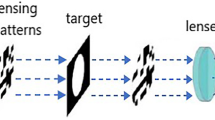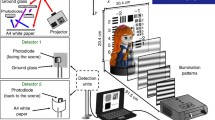The reconstruction methods, which are based on compressed sensing (CS), make it possible to record and reconstruct information basing on its sparse or compressed representation. In this work, we study resistance of CS-based single-pixel imaging to partial loss of the intensity of the recorded radiation from an object with a limited area of the detector. The problem was solved experimentally by implementing the so-called single-pixel camera, as well as detecting optical radiation from the object and reconstructing its image with the use of CS methods. The method resistance to spatial radiation losses is estimated as a function of the size and shape of the detector aperture. The quality of image reconstruction depending on the two following factors is assessed: the fraction of the intensity of the detected radiation and the quantity of single-pixel detections. The results can ensure significantly wider application of the method to reconstruct data, both detected in dynamic and scattering media (including the introduction of various apertures and Fourier filtering) and in the case of significant spatial radiation losses.
Similar content being viewed by others
References
S. Mallat, A Wavelet Tour of Signal Processing: The Sparse Way, Burlington: Academic (2009). https://doi.org/https://doi.org/10.1016/B978-0-12-374370-1.X0001-8
R. Lukac, Computational Photography: Methods and Applications, Boca Raton: CRC Press (2016).
E. J.Cand’es and M.B.Wakin, IEEE Signal Proc. Mag., 25, No., 2, 21–30 (2008). https://doi.org/https://doi.org/10.1109/MSP.2007.914731
M. Rani, S.B.Dhok, and R.B. Deshmukh, IEEE Access, 6, 4875–4894 (2018). https://doi.org/https://doi.org/10.1109/ACCESS.2018.2793851
F. Zhang, X. Liang, R.Cheng, et al., IEEE Geosci. Remote Sen. Lett., 17, No. 3, 446–450 (2020). https://doi.org/https://doi.org/10.1109/LGRS.2019.2926301
C. M.Watts, D. Shrekenhamer, J.Montoya, et al., Nat. Photon., 8, 605–609 (2014). https://doi.org/https://doi.org/10.1038/nphoton.2014.139
M. F. Duarte, M.A.Davenport, D.Takhar, et al., IEEE Signal Proc. Mag., 25, 83–91 (2008). https://doi.org/https://doi.org/10.1109/MSP.2007.914730
W. Zhang, L.Cao, D. J. Brady, et al., Phys. Rev. Lett., 121, No. 9, 093902 (2018). https://doi.org/https://doi.org/10.1103/PhysRevLett.121.093902
M.P. Edgar, G.M.Gibson, and M. J.Padgett, Nat. Photon., 13, No. 1, 13–20 (2019). https://doi.org/https://doi.org/10.1038/s41566-018-0300-7
M.-J. Sun, M. P. Edgar, G.M.Gibson, et al., Nat. Commun., 7, 12010 (2016). https://doi.org/https://doi.org/10.1038/ncomms12010
V.G. Rodin, Komp. Optika, 42, No. 3, 347–353 (2018). https://doi.org/10.18287/2412-6179-2018-42-3-347-353
I. N.Kompanets and A. L. Andreev, Quantum Electron., 47, No. 4, 294 (2017). https://doi.org/https://doi.org/10.1070/QEL16293
M. N.Kulakov, R. S. Starikov, and P. A.Cheremkhin, KnE Energy, 3, No. 3, 509–522 (2018). https://doi.org/10.18502/ken.v3i3.2065
N. Gopalsami, S. Liao, T. W. Elmer, et al., Opt. Eng., 51, No. 9, 091614 (2012). https://doi.org/https://doi.org/10.1117/1.OE.51.9.091614
M.Kowalski, M. Piszczek, M. Szustakowski, and W.Ciurapinski, in: Proc. 23rd DAAAM Int. Symp. Intelligent Manufacturing Automation 2012. Zadar, Croatia, 24–27 October 2012, 1, 309-312 (2012).
E.Tajahuerce, V. Duran, P.Clemente, et al., Opt. Express., 22, 16945–16955 (2014). https://doi.org/https://doi.org/10.1364/OE.22.016945
V.Duran, F. Soldevila, E. Irles, et al., Opt. Express, 23, 14424–14433 (2015). https://doi.org/https://doi.org/10.1364/OE.23.014424
M. A. Neifeld and J.Ke, Appl. Opt., 46, No. 22, 5293–5303 (2007). https://doi.org/https://doi.org/10.1364/AO.46.005293
Y. Juregui-S’anchez, P.Clemente, J. Lancis, and E.Tajahuerce, Opt. Lett., 44, No. 3, 679–682 (2019). https://doi.org/https://doi.org/10.1364/OL.44.000679
Y. Jauregui-S’anchez, P.Clemente, P. Latorre-Carmona, et al., Appl. Opt., 57, No. 7, B67–B73 (2018). https://doi.org/https://doi.org/10.1364/AO.57.000B67
M.Wenwen, S.Dongfeng, and H. Jian, Opt. Express, 27, No. 22, 31490–31503 (2019). https://doi.org/https://doi.org/10.1364/OE.27.031490
W. Huang, L. Xiao, H. Liu, and Z.Wei, Sensors, 15, No. 1, 2041–2058 (2015). https://doi.org/https://doi.org/10.3390/s150102041
P. Wijesinghe, A. Escobet-Montalbán, M. Chen, et al., Opt. Lett., 44, No. 20, 4981–4984 (2019). https://doi.org/https://doi.org/10.1364/OL.44.004981
Q. Z.Wang, X. Liang, L.Wang, et al., Opt. Lett., 20, 1498–1500 (1995). https://doi.org/https://doi.org/10.1364/OL.20.001498
E.Berrocal, S. G. Pettersson, and E.Kristensson, Opt. Lett., 41, 5612–5615 (2016). https://doi.org/https://doi.org/10.1364/OL.41.005612
M. V. Afonso, J.M.Bioucas-Dias, and M.A.T. Figueiredo, IEEE Trans. Image Proc., 19, 2345–2356 (2010). https://doi.org/https://doi.org/10.1109/TIP.2010.2047910
N. N. Evtikhiev, V. V.Krasnov, I. D.Kuzmin, et al., Quantum Electron., 50, No. 2, 195 (2020). https://doi.org/https://doi.org/10.1070/QEL17139
I. S. Gibin, V. I.Kozik, and E.S.Nezhevenko, Optoelectr. Instr. Data Proc., 56, No. 1, 1–9 (2020). https://doi.org/https://doi.org/10.3103/S875669902001001X
D.Yu.Molodtsov, P.A.Cheremkhin, V.V. Krasnov, V.G. Rodin, J. Phys: Conf. Series, 737, 012074 (2016). https://doi.org/https://doi.org/10.1088/1742-6596/737/1/012074
Z. Zhang, X. Ma, and J. Zhong, Nat. Commun., 6, 6225 (2015). https://doi.org/https://doi.org/10.1038/ncomms7225
I. A. Shaikin, Radiophys. Quantum Electron., 61, No. 12, 924–929 (2019). https://doi.org/https://doi.org/10.1007/s11141-019-09948-z
D. Salomon and G. Motta, Handbook of Data Compression, Springer-Verlag, London (2010).
Q. Chen, D. J.Chen, J.Gong, and J. Ruan, Entropy, 22, 125 (2020). https://doi.org/https://doi.org/10.3390/e22010125
P. A. Cheremkhin and E.A.Kurbatova, Opt. Laser. Eng., 115, 119–130 (2019). https://doi.org/https://doi.org/10.1016/j.optlaseng.2018.11.019
Author information
Authors and Affiliations
Additional information
Translated from Izvestiya Vysshikh Uchebnykh Zavedenii, Radiofizika, Vol. 63, Nos. 8, pp. 646–657, January 2020.
Rights and permissions
About this article
Cite this article
Kulakov, M.N., Rodin, V.G., Starikov, R.S. et al. Influence of Spatial Losses of the Signal Detected by a Single-Pixel Detector on the Quality of Object Image Reconstruction. Radiophys Quantum El 63, 582–591 (2021). https://doi.org/10.1007/s11141-021-10081-z
Received:
Accepted:
Published:
Issue Date:
DOI: https://doi.org/10.1007/s11141-021-10081-z




